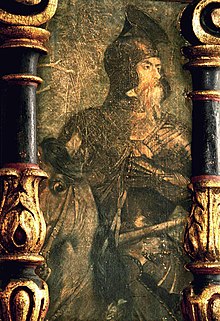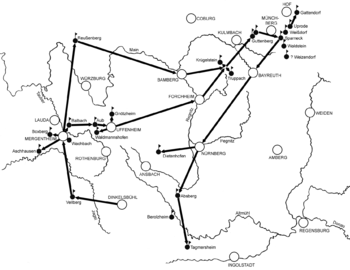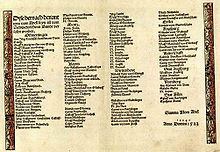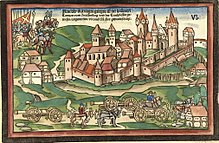Frankish War
The Franconian War existed in 1523 in the course of the Swabian Federation against several robber barons' castles , whose owners supported Hans Thomas von Absberg in the Absberg feud .
Definitions
The term Franconian War
Compared to other wars and battles, the Frankish War remained manageable in its scope and the theater of war was limited to the Franconian area. In a narrower sense, the term Franconian War denotes the procession of the Swabian Federation against 23 castles in June and July 1523. When the term Franconian War came up is still unclear, but acts of war were already mentioned in the documentation of the events immediately after 1523 . In the 19th century the term took on a romanticizing note. Most historians today use the term because it also expresses the fact that two opponents with opposing interests faced each other and that the situation was more complex than one might think if one simply called it the persecution of robber knights . Similar causes also led to the Palatine War of Knights at the same time .
The term Absberg feud
Long before 1523, Hans Thomas von Absberg had begun kidnapping Nuremberg and Augsburg merchants as well as imperial diplomats while they were passing through. While the raids often took place in what is now Lower Franconia , he concealed the whereabouts of the abductees, placed them in various castles and kept changing their location. His relationships extended far into Bohemian areas, so he was able to hide his own whereabouts again and again and evade persecution. He continued his raids after 1523, but was finally murdered by a henchman in 1531. The Nuremberg War Room documented and fought the attacks by Hans Thomas von Absberg between 1519 and 1530.
The feuds was to legitimate in this time means to enforce interests. For the declining Frankish imperial knighthood , it was also a means of confrontation with the emerging territorial states, such as the bishopric of Bamberg and the burgraviate of Nuremberg as well as the resulting margravates of Kulmbach and Ansbach . The robber barons, who mostly misused this instrument, because a feud had to be. a. be announced and required a justification, formed the end of the feud. It was replaced by an ever more effective land peace . The waiting order of 1498 shows how Margrave Friedrich tried to arm himself against internal conflicts.
Course of the Franconian War
Starting position of the Swabian Federation

The Swabian Confederation, which can be understood as the first attempt at a regulatory power, was called on by the imperial city of Nuremberg for help. The alliance was designed in such a way that the federation stood by its members to maintain the peace. The Swabian Federation, which, as the name suggests, had its roots in the Swabian region, included Swabian and Franconian imperial estates, as well as various Franconian imperial cities and territorial lords, for example the Würzburg monastery . Under the leadership of Nuremberg, the Bund began to form a powerful army from contingents of its members. The list of castles that Nuremberg wanted destroyed was long - in negotiations among the members of the Federation, an agreement was finally reached in 1522 on the castles, which were then tackled.
According to Roth von Schreckenstein , the Swabian Federation included members of the following Bavarian , Franconian and Swabian families: Seckendorff , Stain , Reischach , Wellwart , Schwendi , Echter , Torringer , Seibolstorff , Nothaft , Preysing , Nussberg, Hundt , Freiberg , Auer , Spoonholz , Ehingen , Hürnheim , Sotzingen , Thumb , Gültlingen , Rieringen , Ow to guard the village and Knoringen . Various Counts of Oettingen also joined. An exact contemporary listing can be found in the Bamberg Castle Book .
Starting position of the robber barons around Hans Thomas von Absberg
Various reasons led to the creeping decline of chivalry, for example the loss of importance in relation to territorial states or cities with lively trade relations or the loss of function as a war unit. Noble families who had mastered this structural transition usually placed themselves in the service of a sovereign and received important posts as court masters or bailiffs . Nevertheless, Hans Thomas von Absberg had strong support in the Franconian knighthood, his closest followers came from well-known families, such as the families von Rosenberg , Thüngen , Guttenberg , Wirsberg , Sparneck and Aufseß . During his raids he benefited from the Frankish area, which was politically divided into many small areas. In addition to imperial-free property, the borders of the monasteries Bamberg and Würzburg , Brandenburg-Kulmbach and the road to Bohemia and Saxony were close together.
Supraregional connections
The Swabian Federation not only took the duty of assistance for the imperial city of Nuremberg as a member seriously, it also had cause for concern about a connection between Ulrich von Württemberg, who had just been defeated, and Franz von Sickingen . Franz von Sickingen's raids extended as far as Trier and he had strong support from the Central German knighthood. Even if Sickingen had succumbed to the consequences of his combat injuries in May 1523, the Palatinate knight revolt and the peasants' war that broke out a few years later were widespread unrest that endangered the strengthening principalities.
Destruction by the Swabian Federation in 1523
Main article: Wandereisen woodcuts from 1523
Before the procession of the Swabian Federation started, the knights who were accused of breaking the peace were given the opportunity to purify themselves . Some of them could acquit themselves in this way, others were not allowed to be cleaned. Other knights ignored the request. War correspondent Hans Wandereisen recorded the events of 1523 in 23 woodcuts . At the end of the campaign, some families managed to reconcile with the Swabian League and to keep their property by paying a sum of money and promising to keep the peace. Other knights, however, continued their raids in the wake of Thomas von Absberg, so that in 1527 different villages set up mounted patrols in order to contain the attacks on travelers.
aftermath
Horst Carl sees the events of 1523 as a formative moment for Franconia and Swabia. The image of “Franconian troublemakers and Swabian law enforcement officers” has had a lasting impact on both regions in their portrayal of themselves and from the point of view of the other region.
literature
Modern specialist literature
- Horst Carl: The Swabian Federation 1488–1534. Country peace and cooperative society in the transition from the late Middle Ages to the Reformation (= writings on Southwest German regional studies. Vol. 24). DRW-Verlag, Leinfelden-Echterdingen 2000, ISBN 3-87181-424-5 , pp. 472-480, (at the same time: Tübingen, University, habilitation paper, 1998).
- Horst Carl: Franconian troublemakers and Swabian law enforcement officers? - Swabian and Franconian regional awareness in the context of early modern politics. In: Thomas Kühne, Cornelia Rauh -Kühne (Ed.): Space and History. Regional traditions and federal orders from the early modern period to the present (= writings on Southwest German regional studies. Vol. 40). DRW-Verlag, Leinfelden-Echterdingen 2001, ISBN 3-87181-440-7 , pp. 24-37.
- Karl Heinz Kalb: On the nature of warfare at the beginning of modern times. Their effects on the upper Main (= official school gazette for the administrative district of Upper Franconia. Local supplement . No. 58, ZDB -ID 583304-8 ). Government of Upper Franconia, Bayreuth 1977.
- Peter Ritzmann: "Plackerey in teutschen Landen". Investigations into feuding activities of the Franconian nobility in the early 16th century and their fight against them by the Swabian Federation and the Imperial City of Nuremberg, in particular using the example of Hans Thomas von Absberg and his dispute with the Counts of Oettingen (1520–31). Dissertations-Verlag NG-Kopierladen GmbH., Munich 1995, ISBN 3-928536-50-8 (At the same time: Munich, University, dissertation, 1994).
- Reinhardt Schmalz: The Franconian War 1523 and the guilt of the Sparnecker. In: Archive for the history of Upper Franconia . Vol. 85, 2005, pp. 151-158.
- Thomas Steinmetz: Conterfei a number of acts of war from 1523 to the 1527 Jar - to representations of castles about the "Absberg feud" or the "Franconian War". In: Contributions to the exploration of the Odenwald and its peripheral landscapes. Vol. 4, 1986, ZDB -ID 553263-2 , pp. 365-386.
Classical specialist literature
- Joseph Baader : The feud of Hans Thomas von Absberg against the Swabian Federation. A contribution to the cultural history of the sixteenth century. Kellerer, Munich 1880.
- Joseph Baader (Ed.): Negotiations about Thomas von Absberg and his feud against the Swabian Federation 1519 to 1530 (= Library of the Litterarian Society in Stuttgart. Vol. 27, Publication 1 = Publication 114, ZDB -ID 519450-7 ). At the expense of the Litterarian Association, Tübingen 1873, digitized .
- Johann Heilmann : War history of Bavaria, Franconia, Palatinate and Swabia from 1506 to 1651. Volume 1: War history and warfare from 1506–1598. Literary-artistic establishment of the GJ Cotta'schen Buchhandlung, Munich 1868, pp. 29–36 .
- Karl Freiherr von Reitzenstein : The Swabian Federation in Upper Franconia or the House of Sparneck case 1523. Files on Franconian history. Kühn, Weimar 1859, digitized .
- Karl Heinrich Freiherr Roth von Schreckenstein : History of the former free imperial knighthood in Swabia, Franconia and on the Rhine, edited from sources. Volume 2: From 1437 until the repeal of imperial knighthood. Laupp, Tübingen 1862, pp. 249-253 .
Individual evidence
- ^ Karl Heinrich Freiherr Roth von Schreckenstein : History of the former free imperial knighthood in Swabia, Franconia and on the Rhine, edited from sources . Second volume. Tübingen 1862, p. 250.
- ↑ List of persons Abconterfeyung 1523 on Wikisource



